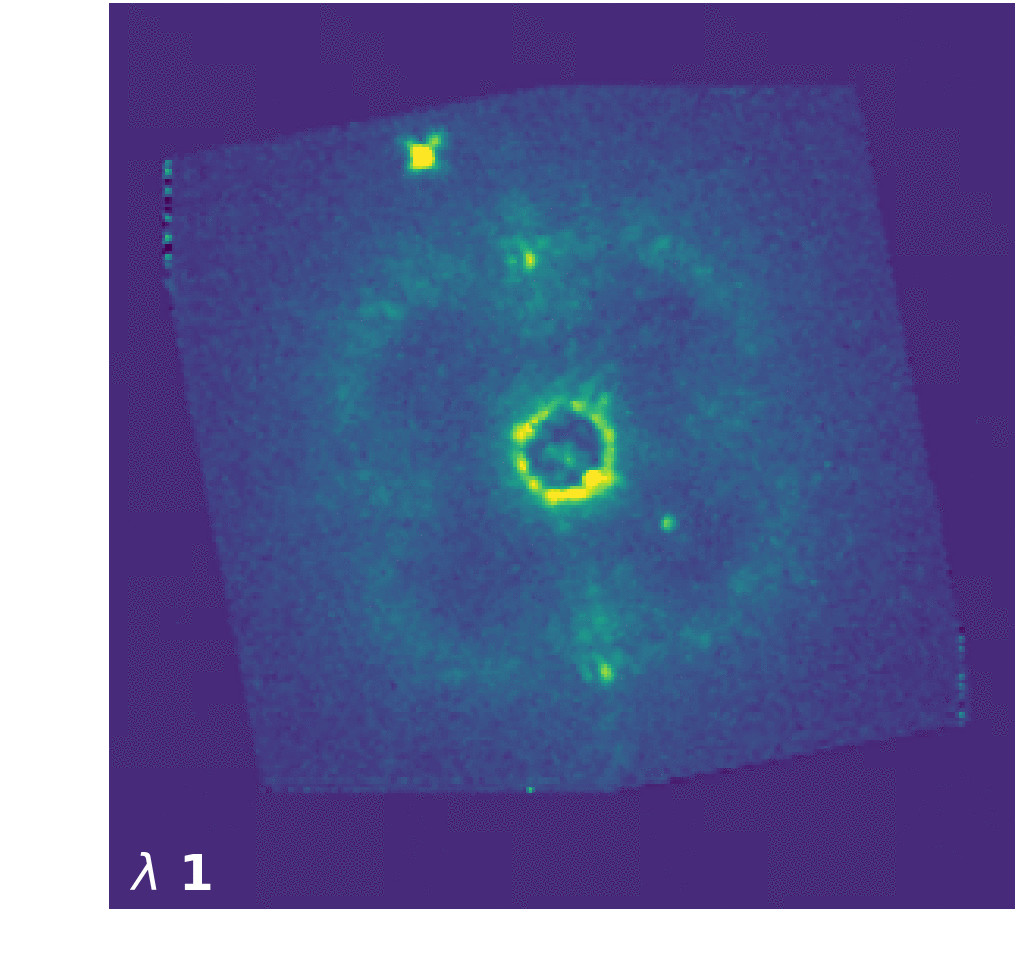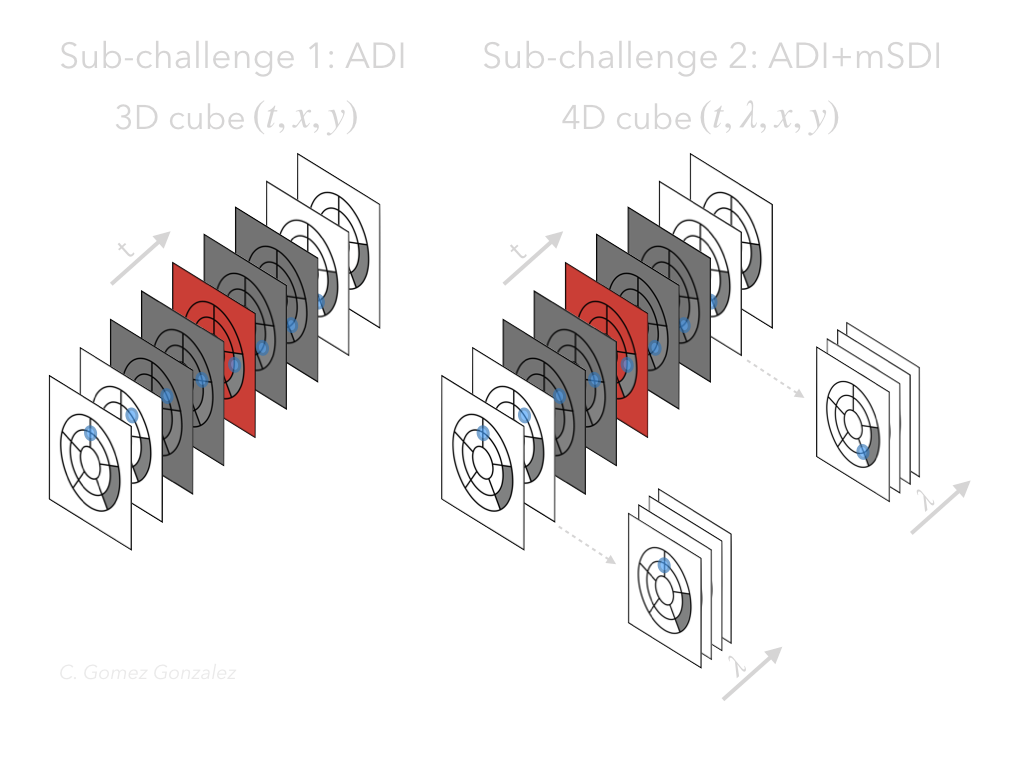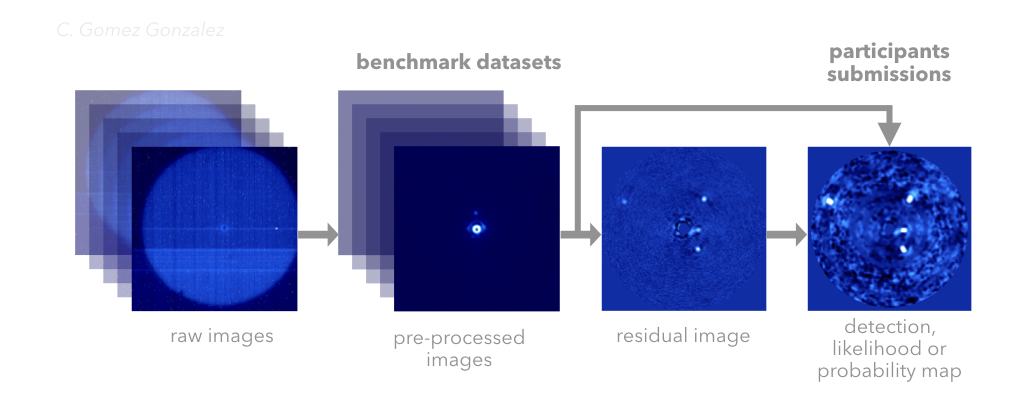Detection of exoplanets
In the first phase of the Exoplanet Imaging Data Challenge, the focus is exclusively on the detection of point-like sources (exoplanets) within high-contrast images taken with ground-based telescopes.
A multitude of high-contrast imaging post-processing algorithms and pipelines have been developed in the past fifteen years to detect faint planetary signals within astronomical images. Pueyo (2018) offers an ample discussion on the exoplanet detection algorithms proposed in the literature. You may refer to the Bibliography tab for more reference about the latest image processing techniques dedicated to HCI.
Two sub-challenges:
This competition is composed of two sub-challenges corresponding to the two most widely used observing techniques:
- Pupil tracking observations (angular differential imaging, ADI),
- Multi-spectral imaging, combined with pupil tracking (multi-channel spectral differential imaging, ADI+mSDI).
Sub-challenge #1: ADI
In pupil-stabilized or pupil-tracking observations the telescope pupil is stabilized on the detector and the field of view rotates in step with a given angle (the parallactic angle). This generates a fake movement of the companions in a circular trajectory around the center of the image, the place where the star is located. This generated diversity makes it possible to disentangles the exoplanet signal (rotating) from the speckle field (quasi-static). ADI-based post-processing techniques exploit this diverstity to unveil the faint planetary signals. The video below explains the concept of ADI observation technique.
The so-called “ADI datasets” are composed of:
(i) a cube of images (x,y,t) acquired during a 1h to 3h observing sequence (see figure below);
(ii) the corresponding parallactic angles variation during the observing sequence;
(iii) the point-spread function (PSF) of the instrument (a non-saturated or non-coronagraphic image of the target star) acquired around the observing sequence.
90 Seconds of Astronomy - Angular Differential Imaging from nadara on Vimeo.
Sub-challenge #2: ADI+mSDI
In the case of multi-spectral imaging, an integral field spectrograph (IFS) disperses the light, providing simultaneously, for each exposure, several monochromatic images. The resolution and wavelength coverage varies depending on the instrument used. The speckle distributions (and more generally the starlight residuals) vary with the wavelength (see figure below), while the planetary signal's centroid remains static. This diversity also makes it possible to disentangles the exoplanet signal (static) from the speckle field (moving radially). SDI-based post-processing techniques exploit this diverstity to unveil the faint planetary signals. Multi-spectral imaging is usually combined with ADI.
The so-called “ADI+mSDI datasets” are composed of:
(i) a 4D cube of images (see figure below);
(ii) the corresponding parallactic angles variation along the temporal dimension;
(iii) the corresponding vector of wavelenghts along the spectral dimension;
(iv) the point-spread function (PSF) of the instrument.

Dimensionality of the data for the two sub-challenges
The figure below shows the dimension of the two type of data set, corresponding to each sub-challenge.

Typical process to detect point source
The figure below shows an schematic representation of an HCI point source detection pipeline. In this phase of the data challenge, we do not use datasets with known (real) companions. Instead, we injected synthetic planetary signals in the data in order to measure the detection capability of different algorithms. Each challenge cube contains from none to five synthetic point-sources, injected using a standard process (without accounting for smearing or any source of variable photometry). For spectrally dispersed data we additionnaly use three empirical field brown dwarf template spectra for the injection of the synthetic planetary signals in the different spectral channels.

Note on RDI: Although Referential Differential Imaging (RDI) does not constitute a separate sub-challenge, we welcome submissions that make use of reference datasets or libraries (whether it is the cubes provided within the challenge or external ones). We only require the participant to make clear if RDI is used instead of pure ADI or ADI+mSDI post-processing (this is explained on the “metrics” sub-section on the top navigation bar).